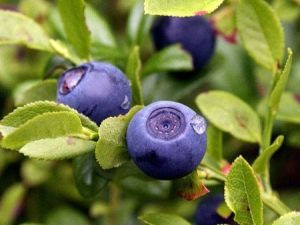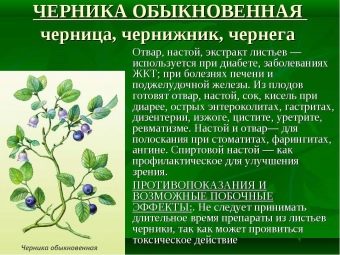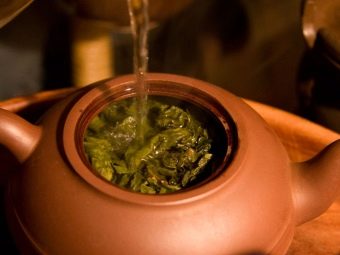Bilberry shoots: beneficial properties and contraindications

Blueberries are one of the few wild plants that have not only tasty and healthy berries, but also shoots with leaves that have medicinal properties.This is a branched shrub that reaches 40-50 cm in height, with thin oval, finely toothed leaflets. Bilberry ordinary blooms in May, and its black with a blue-bluish bloom berries begin to ripen in July and delight us until late autumn. Blueberry bushes can be found on wet, marshy lands, semi-shaded plains, in spruce, pine, mixed forests.
Special features
The leaves and shoots are collected during the flowering period (May-June), berries - from July-August. The shoots are dried away from direct sunlight, ensuring free access of air. Berries are used fresh. For storage they are subjected to drying or deep freezing. Dried shoots of blueberries in the case of compliance with all the rules of harvesting and storage up to two years, do not lose their qualities.
In leaves and shoots there is a large amount of tannins and vitamin C. An important biological role that determines their beneficial properties is played by flavonoids (quercetin), glycosides (neomirtillin, myrtillin), and also fenologlycoside arbutin.
Blueberries have a lot of natural sugars (lactose, fructose), pectin, organic acids, microelements, vitamins (C, A, P-group), tannins. A significant role is played by anthocyanin glycosides, of which there are many in the fruits of the plant and sufficient in the leaves (myrtillin).
Properties
The active ingredients listed above provide preparations from fruits and leaves of blueberries with many useful properties:
- astringent, anti-rotten;
- antispasmodic;
- anti-inflammatory, antiseptic;
- hemostatic;
- choleretic;
- diuretic;
- normalizing carbohydrate and salt metabolism;
- strengthens capillaries and blood vessels, improves tissue trophism;
- vasodilating, cardiotonic;
- fortifying, immunostimulating.
Biological substances of blueberries are able to inhibit the growth and effect of many disease-causing organisms, including those that cause such diseases as dysentery, typhoid fever and diphtheria. In addition, the antitumor properties of the plant have been experimentally established.
This allows you to successfully apply the dosage form of leaves and blueberries in many diseases.
Application
In official medicine, infusions of blueberry shoots are used to treat mild forms of type 2 diabetes. Their long reception has a positive effect on the work of the pancreas and normalizes blood sugar levels. This blueberry is obliged to glycoside neomyrtilline, a large amount of which is contained in the plant. For treatment, blueberry shoots are used both separately and in collections with other plants (anti-diabetic collection "Arfazetin").
In severe forms of the disease, phytotherapy with blueberries can be successfully combined with medical treatment. In some cases, this can reduce the dose of drugs consumed by the patient inside.
It is no secret that patients with diabetes often have vision problems. In this case, the leaves and fruits of blueberries will be very useful, since they contain a lot of anthocyanins and carotenoids. These compounds accumulate in the retina, strengthen the capillaries, reduce their fragility, which occurs in diabetic angiopathy. They reduce swelling and improve the nutrition of the tissues of the eyeball, suppress the pathological processes of cataract formation. Thanks to these substances, the formation of a photosensitive pigment in the retina of the eye is enhanced and twilight vision is improved, and eye fatigue is reduced.
However, not only diabetics can be useful blueberries. In folk medicine, the shoots and berries of this plant are used to treat many diseases:
- inflammatory bowel diseases (enteritis, enterocolitis), dysentery, diarrhea (due to the astringent and antimicrobial action of blueberries diarrhea, putrid processes will quickly stop, normal bowel function will be restored);
- gastric diseases with reduced acidity;
- cystitis, inflammatory processes in the kidneys (the positive effect in the treatment of these diseases is explained by the diuretic, antiseptic, anti-inflammatory and antispasmodic action of the plant);
- gout, cholelithiasis and urolithiasis;
- uterine bleeding, hemorrhoids (the infusion of the shoots will remove bleeding, inflammation, pain and swelling);
- skin diseases (eczema, fungal infections), burns;
- pharyngitis, stomatitis, gingivitis;
- colds, upper respiratory tract diseases;
- anemia, avitaminosis.
How to use?
From the shoots and fruits are prepared infusion. The proportions of raw materials and water for an infusion are different depending on the disease, there may also be slight differences in the preparation.
Usually the infusion is prepared as follows. A tablespoon of raw materials (with top) should be placed in a porcelain or enameled container, pour in 200 ml of boiling water, close and place in a pan with boiling water for 15 minutes. Let it brew for 45 minutes, then strain and squeeze the raw material. If necessary, the infusion is adjusted with boiled water to 200 ml. The resulting solution, adults drink 100 ml 3 times daily before meals. It is necessary to drink medicine warm, having shaken up before reception.
Children are prescribed blueberry treatment by a doctor, and the doses, respectively, are lower for them than for adults: from 10 to 50 ml per reception, depending on age.
And here is another recipe that makes it easy to make a healthy drink. 50-60 g dried shoots of blueberries pour a liter of water and boil on low heat for 5 minutes. Cool for an hour, then strain, squeeze and bring to a liter of boiled water. Adults drink like ordinary tea.
The same infusion will reduce pain and inflammation in hemorrhoids, if used for an enema.
High-quality raw materials from environmentally friendly places can be purchased at pharmacies. Bilberry shoots usually come in packs with a total weight of 75 grams or in filter bags. Dried blueberries can be bought there.
You should not buy medicinal raw materials from blueberries from random individuals, because not only the therapeutic effect, but also the safety of the reception depends on it.
Contraindications
Despite the widespread use and the fact that when taken orally, blueberry dosage forms are well tolerated, There are some contraindications to receive.
- Hypersensitivity. Allergies to blueberries can manifest as itching and skin rashes. In this case, the reception should be stopped and take antihistamines.
- Children's age up to 3 years. For young children, only a doctor can prescribe blueberries.
- Tendency to constipation. The astringent effect of blueberry infusions can only further aggravate the problem.
- Dyskinesia of the biliary tract.
Pregnant and lactating women can use blueberries only after consulting with a specialist.
You can learn more about blueberry properties in the following video.

































